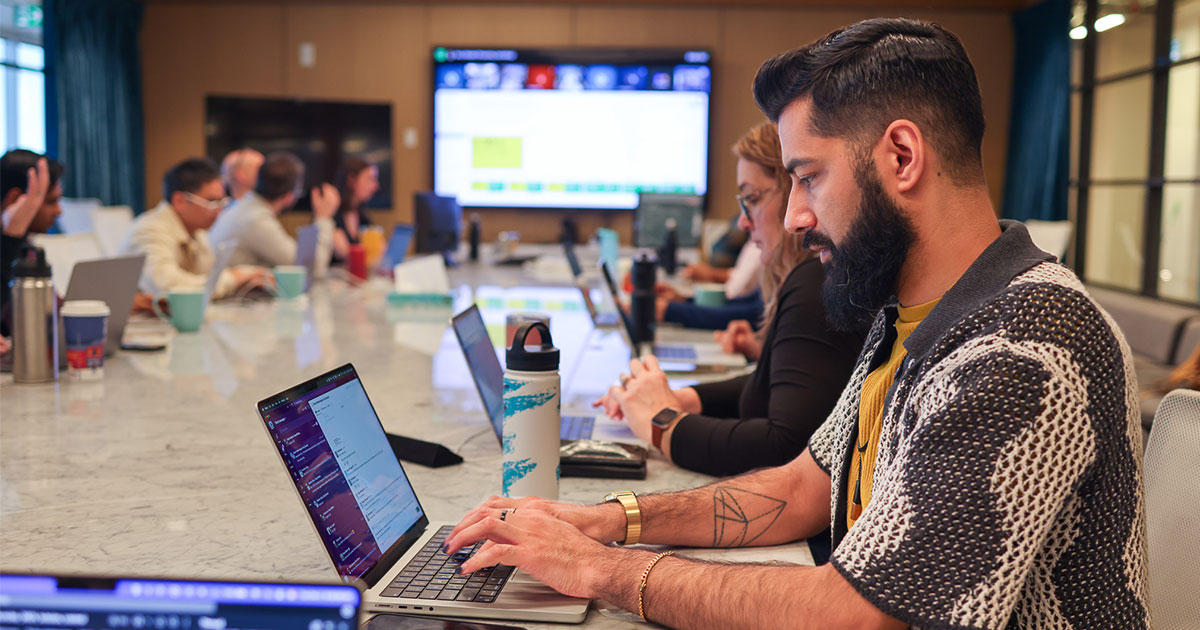A new, collaborative approach to community investment is on the rise as more companies choose to include diverse groups of stakeholders in granting decisions.
It’s happening for good reason: Employees, consumers, community members and partners increasingly want to work for and support businesses who care about social and environmental issues. And it’s not just about seeing whether companies care about their values — these stakeholders want a say in how businesses allocate their philanthropic dollars.
This eagerness to evolve the traditional corporate model — companies deciding where they’ll invest budgets and nonprofits competing for support through grant applications — comes from some major societal shifts. The pandemic, the racial justice movement, climate change and the Great Resignation have left people expecting companies to act.
At the same time, companies are taking a different approach to their relationships with nonprofits. By moving to a model of trust-based philanthropy, they’re focusing on building strong ties founded in true partnership, rather than asking grantees to cater to their requirements.
There’s a name for this new approach: Stakeholder Philanthropy

At Benevity, we wanted to find out how employees and consumers felt about the way companies approached corporate giving. We commissioned a survey of 1,000 American adults to explore their views. The results were eye-opening:
- 78% of employees were likely to work for an organization who provides transparency into how they allocate charitable donations, while 73% of consumers were likely to shop at or support an organization who seeks their input on where the organization gives.
- 84% of consumers and 86% of employees believed that customers, employees and investors should have the opportunity to be involved in corporate giving.
Many forward-thinking companies have heard their stakeholders loud and clear. And now they’re involving more groups of people — employees, consumers, community members, partners and investors — in their community investment decision-making.

Stakeholder philanthropy coming to life
Stakeholder philanthropy was top of mind at Goodness Matters 2022. Our annual conference brought together 1600+ corporate social responsibility (CSR) pros and nonprofit partners, and we heard them speak on the industry’s hottest topics and emerging trens. It was clear that moving toward a more inclusive approach to corporate giving was a priority for CSR leaders — and some have already started.
Engaging stakeholders — from employees to customers to partners — in community investment decisions is a powerful lever to increase employee engagement, customer affinity, social impact and brand trust. And the purpose-driven brands who are leading this charge are already seeing strong results.
Let’s take a closer look at why they’re leaning into this new approach and the successes they’ve seen so far:

Calling for humility and transparency to shift a historical power imbalance

Traditional granting processes position companies as the decision-makers. The onus is then on nonprofits to complete extensive paperwork to make their case to receive funding.
Caitlan Cole, former Collaboration Coordinator at the Trust-Based Philanthropy Project, has first-hand experience of the pitfalls of traditional granting models and their impact on nonprofits. In her session at Goodness Matters, Cole explained how the traditional system just isn’t working anymore, based on her tenure as a grants manager for a U.S. public school. In the role, she often applied for as many as 60 grants per year and only received 25.
In the traditional grant application process, nonprofits bend their needs to meet grant requirements and spend a significant amount of time on the applications themselves, often telling funders basic information that can easily be found online. All this paperwork takes nonprofits away from their mission-critical work, Cole said.
And while companies often want to know what outcomes they’ll see after providing funding, social change work — such as poverty alleviation or climate change — can take decades and be hard to quantify.
Funders should be coming to the table with humility and transparency and embrace a learning mindset, while understanding that systemic change takes time and they may not even witness it in their lifetime. Once nonprofits can be open and honest in their applications, Cole said funders can give organizations the unrestricted, multi-year funding they need to make a meaningful impact in their communities and play a vital role in generational change.
“For many nonprofits, this [grant] is their livelihood. They can’t do their programs unless they have external funding. It’s very stressful to feel as though you’re constantly trying to know what you need, but you’re just trying to perform,” Cole said.
In this way, funders are often making it harder for nonprofits, even though it’s not their intention.

Putting nonprofits at the center of community investment at CSAA

Before joining CSAA Insurance Group as a Community Impact Consultant, Dustin Cooper spent a decade working in the nonprofit sector, directing large-scale programs and working with a myriad of funders, including federal, state, private and corporate.
Cooper witnessed funders centering themselves in their own goals and strategies, rather than centering the needs of their nonprofit partners.
Now on the corporate side of philanthropy, Cooper works to ensure CSAA takes a nonprofit-centered approach to their community investment programs. In practice, it means building everything on a foundation of trust.
In his session at Goodness Matters, Cooper explained that a "nonprofit-centered approach really means being in community with each other and being open and honest with our nonprofit partner. It leads to them letting us know if there are things we're not doing correctly, if some events aren't the most beneficial, or [if] there’s funding that's aligned to our strategy but isn't what they need.”
CSAA’s approach includes streamlining their grant application process and offering unrestricted grants, meaning they don’t burden their nonprofit partners with complex applications, and they don’t require the organizations to submit quarterly impact reports. Instead, CSAA verifies information, has a quick call with an interested nonprofit partner and then trusts them as the experts in their field. There are no evaluations or follow-up reports. Only an optional end of year survey that requests demographic and income information of the clients the non-profit serves.
"Our goal is to trust our nonprofit partners and trust ourselves by doing the due diligence. We know who is doing the best work in the field and we know where our dollars are going most effectively," Cooper said.
While CSAA has shifted from a transactional approach to a transformative approach to be the best corporate partner possible and set their nonprofit partners up for success, transformational change takes time. It’s an iterative process.
Part of the journey, Cooper said, involved learning how to have challenging conversations so that he could ensure CSAA was prioritizing their nonprofit partners in each decision they made.
CSAA was proud of its volunteer program, with its 100% volunteer participation rate, but they chose to examine it through a more critical lens. And when they took a closer look, CSAA saw there was a portion of that volunteer engagement that wasn't as impactful as it could be — because it was being driven by CSR reporting based on internal metrics, rather than focused on external impact.
To better center nonprofits in decision-making, Cooper recommended including external impact and qualitative stories when reporting internal metrics to leadership — focusing on the impact and benefits to the nonprofits (in addition to the employees who are volunteering).
"Remember to make sure, as we all strive toward reaching the internal metrics and volunteer rates, to center our nonprofits in all the decisions we make,” he said.

A community-centered approach to granting at Zoom

In her Sharing Power to Advance Impact session, Georgette Bhathena, Senior Program Manager, Social Impact at Zoom, explained how the company takes what they call a community-centered approach to grantmaking. They believe in sharing the power and decision-making. As a company, they focus on addressing timely intersectional issues through their community investment work: social equity, youth mental health, education and the environment. When they undertake a granting round, they work with community advisors who have deep knowledge of the issues affecting their communities and their stakeholders.
Those community advisors are the ones who nominate organizations to receive funding. Zoom leverages its grantmaking to support organizations under $5M in size with multi-year grants, flexible funding, no applications and limited reporting requirements. In 2021, $11.3M in grants were funded by Zoom.
“By working with community advisors with deep issue understanding and lived experience, we believe that these experts know the solutions needed to enact change in their communities. Our social impact efforts at Zoom could not be achieved without their help," Bhathena said.
Zoom is also using their product as a lever for change. Their product donations and offerings allow organizations to worry less about how to pay for technology solutions and focus on delivering their innovative, community-centred solutions to the people they serve. In the 2022 fiscal year, they provided $3.4M of in-kind product donations to 33 organizations in 10 countries.
Zoom’s technology is relied on by many nonprofits to enable them to expand their reach, engage their communities and deliver critical services to the communities they serve, Bhathena said.

Stakeholder philanthropy is the way forward for purpose-driven brands
Employees and community members have valuable lived experiences. Inviting them to the table to be a part of the nomination process and decision-making helps companies drive critical funding to support equity, diversity and systemic change — including how they engage in corporate giving. Purpose-driven brands have the chance to make an even greater impact — on their business and on important social and environmental issues — when they embrace stakeholder philanthropy.

Benevity’s Community Investment Solution can help you kick-start or accelerate your stakeholder philanthropy journey. Learn More









